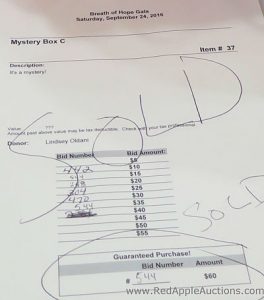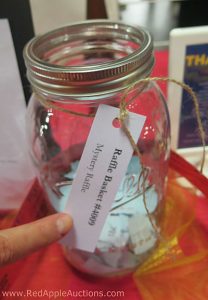
These three surprise / mystery boxes sat on the silent auction tables for bidding. They all sold at twice their value, despite guests not knowing what was inside.
I want to share a new idea for silent auctions or raffles.
Let’s kick it off with a related story.
============================
Many years ago, one of my clients was annoyed.
She oversaw the fundraising for the local chapter of a national nonprofit. The national management team had recommended she and other fundraisers working in major cities change the model of their silent auction.
This new silent auction model was based on the success another major metropolitan area had experienced when all of the silent auction items had become “mystery gifts.”
As I understood it, the silent auction tables had attractively wrapped boxes where displays used to be. A sign might say “A Trip” or “A Night Out.”
Guests were asked to pay a substantial flat rate for the box, perhaps from $250 to $5000, without knowing what was inside.
Re-read that. These aren’t $25 mystery boxes, but $2500 mystery boxes.
There were no silent auction bid sheets — only “buy” sheets.
She told me that this other metropolitan area had remarkable success. Guests swooped in to buy all the “mystery silent auction items” in short order. The development team didn’t have to write descriptions, create bid sheets, take photographs, or create other marketing promotions.
My client rolled her eyes.
“That might work fine there because the donor base is “old money” with families who have supported them for years,” she explained, “But here in D.C., my donors work for their money. They have jobs; they need to know what they’re buying.”
“Not every major market is the same,” she concluded.
When it came time for her event, she didn’t follow the advice of her national organization. She kept a traditional silent auction.
============================

“Mystery Box C” sold at the Guaranteed Purchase of $60.
I share her story because a few of my clients use a modified concept of this ‘mystery box’ idea.
To avoid jargon confusion, for the remainder of this blog post, I’m calling this idea a “Surprise Box.”
The fundraising auction industry already has a concept called “Mystery Boxes.” I don’t want us to confuse these two ideas.
============================
Instead of having the entire silent auction become “surprise items,” set aside one or two items and market them as having secret contents.
The Surprise Box will be displayed as you do your other items — a bid sheet, a vertical descriptive sheet, a prop (that is, the box itself) — but the description will indicate that you’re not revealing the contents.
For example, last fall I worked with a disease-based nonprofit that offered 50 items in its silent auction. Three of the silent auction items were “surprise boxes.”
Every box sold at twice its value (the value was around $30), without guests knowing what was inside.

One of the offerings a guest might win in this bucket raffle was a “Mystery Raffle” basket.
Another example — this spring one of my school clients had a bucket raffle. Multiple baskets were on display. Guests could stuff tickets into the jar of the basket they hoped to win.
The last basket on the table was labeled “Mystery Basket … you never know what you are going to get!”
============================
Here’s a tip for keeping this successful. Be sensitive to what your audience is willing to pay for unknown items.
The first time I saw this concept was in 2007, when I was a fresh-faced auctioneer.
The client had a mix of donations that were too nice to individually sell in a $10 or $20 Mystery Box, yet she lacked space in the silent auction to add any more items.
She took many of the donations — two crystal wine glasses, two or three bottles of wine, tickets to smaller area theaters, picnic supplies, car-related tools, kitchen utensils, etc. — and packaged them together in a bright red, 24″ square box with an enormous white bow. It looked spectacular.
 The value was over $600. The opening bid was ~$300.
The value was over $600. The opening bid was ~$300.
When everything closed, the Surprise Box was the only item without a bid.
At the time, even I didn’t know what was in the box. But boy, I hated that her idea was the only item that hadn’t sold.
“I’ll buy it,” I told her.
“It’s got great stuff in it,” she reassured me.
In hindsight, I recognize the room didn’t have an audience ready to commit to an unknown $300 purchase. It was a smaller auction with many social workers and mental health therapists. They were prepared to spend $300 on a known item, but it was too steep of a price for an unknown investment.
Lesson learned.
============================
Have you used a Surprise Box in your silent auction? How did it go?
I encourage you to post your thoughts below.
we have a church fair every no. to raise money for food pantry, heating help and free meals on sunday n Monday.we have a basket raffle where assorted baskets are donated usually around 70-80 baskets..some we put out for ticket wins others are bid on…..my problem for a few yrs has been everyone knows who is bidding on what baskets…names and phones # go on bidding sheets..last year our new priest ended up paying for 7 baskets because no one wanted to out bid Father……..lol……. ours is a fair with people coming and going all day…we announce the winners at the end of fair…….was wondering if you had a different idea as to how to place a bid , not using your name so it would be secret…………appreciate any ideas you might share..thank you
Jane, I can appreciate your dilemma! I wrote about this in a blog post: The raging debate on silent auction bid numbers versus names.
If you want to limit changes to your process, just switch to requiring telephone numbers. I don’t think most people these days know other people’s numbers. For a back-up, I suppose you could have them use phone numbers and one’s birthday (just the day, such as “27” or “4”).
If you’re willing to add some complexity, you could have guests receive a bid number at registration. They would then bid with the bid number. You may decide to require that they register a credit card in advance — or not, if that seems like overkill for your community.
What is your take on combining mystery bags and mystery boxes for a section of the silent auction? In the past we have used bags but we are hoping boxes might attract a fresh set of eyes.
You could try it. More than anything, success depends on how many you’re trying to sell and the quality inside.
Great ideas overall, but I don’t say anything in your article about complying with local laws. At least two tidbits in the article are not in compliance with Texas gambling or alcohol laws.
Mona, good reminder — it’s always a good idea to check with state laws, and city/county ones. I suspect I could add that to nearly every blog post I write.
I have seen both of these ideas (mystery box AND surprise boxes) – and I have some funny stories for both cases.
I think both can work. I view mystery boxes as a form of raffle and a good way to sell off those lower-priced gift cards (e.g. $20 to Subway). I would recommend that you set the price a bit higher than the average value of the items and use the higher values as an incentive like you do in a wine pull (e.g. values of the $25 box range anywhere from $15-$50)
We here at Handbid did an event once that was all mystery boxes which is not typical for us since we are a mobile bidding platform. But it worked well! We had 100 $100 boxes and the values did range from $70 up to $150 or more. A few of them had some really good stuff in them.
Are they better? Well that is the question. I think when these boxes get too valuable, either turn them into auction items (and save a few back as surprise boxes) or split them up into less valuable boxes. Like you said Sherry, I think it is only a few that are willing to pay $300 for the unknown.
Cool that you saw an “All Surprise Box” event. I haven’t yet, though I’ve seen several raffle-only events whereby the client foregoes a silent auction and instead opts for a raffle during the cocktail hour, adding a live and appeal during the program.
Thanks for sharing
We have offered what we call “Mystery Boxes” at our gala for the past 2 years. The first year we had a small silent auction along with Mystery Boxes; this year we eliminated the silent auction and added to the Mystery Boxes because our silent auction wasn’t very successful AND we needed more space for seating (by eliminating the silent auction tables we were able to add table seating for 48 people). Our boxes sell for $20, $40 and $60 — the box for each level is a commensurate size to the cost (i.e., $20 boxes are smaller than $40 boxes). We place numbers in the boxes that correspond with a prize. The prizes are valued at least $5 more than the price of the box (so all the prizes in the $20 boxes are valued at $25 or more, etc.). There is a poster at the Mystery Box table that displays the list of contents for each level of boxes. Both years that we’ve offered Mystery Boxes, they have sold out in 45 minutes or less! We allow a one-time “do over”–so if you don’t like the prize in the box you purchase, you may exchange it once for another box. Next year will be our organization’s 25th anniversary, so we’re raising the price of the Mystery Boxes to $25, $50 and $75. Our procurement volunteers have found it easier to obtain items for the Mystery Boxes than to find suitable silent auction items. We also have a live auction and a Fund The Need auction–which have incorporated many ideas we have learned from Sherry through her newsletters and webinars!
Theresa, it sounds like the Mystery Box concept is working well for you! The “Surprise Box” is a different, but similar, concept, but it does require a bit of space. Given your table limitations, your approach sounds like the best fit.